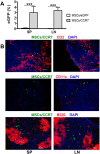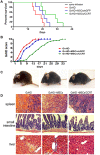CCR7 expressing mesenchymal stem cells potently inhibit graft-versus-host disease by spoiling the fourth supplemental Billingham's tenet
- PMID: 25549354
- PMCID: PMC4280136
- DOI: 10.1371/journal.pone.0115720
CCR7 expressing mesenchymal stem cells potently inhibit graft-versus-host disease by spoiling the fourth supplemental Billingham's tenet
Abstract
The clinical acute graft-versus-host disease (GvHD)-therapy of mesenchymal stem cells (MSCs) is not as satisfactory as expected. Secondary lymphoid organs (SLOs) are the major niches serve to initiate immune responses or induce tolerance. Our previous study showed that CCR7 guide murine MSC line C3H10T1/2 migrating to SLOs. In this study, CCR7 gene was engineered into murine MSCs by lentivirus transfection system (MSCs/CCR7). The immunomodulatory mechanism of MSCs/CCR7 was further investigated. Provoked by inflammatory cytokines, MSCs/CCR7 increased the secretion of nitric oxide and calmed down the T cell immune response in vitro. Immunofluorescent staining results showed that transfused MSCs/CCR7 can migrate to and relocate at the appropriate T cell-rich zones within SLOs in vivo. MSCs/CCR7 displayed enhanced effect in prolonging the survival and alleviating the clinical scores of the GvHD mice than normal MSCs. Owing to the critical relocation sites, MSCs/CCR7 co-infusion potently made the T cells in SLOs more naïve like, thus control T cells trafficking from SLOs to the target organs. Through spoiling the fourth supplemental Billingham's tenet, MSCs/CCR7 potently inhibited the development of GvHD. The study here provides a novel therapeutic strategy of MSCs/CCR7 infusion at a low dosage to give potent immunomodulatory effect for clinical immune disease therapy.
Conflict of interest statement
Figures






References
-
- Billingham RE (1966–1967) The biology of graft-versus-host reactions. Harvey Lect 62:21–78. - PubMed
-
- Kataoka H, Ohtsuki M, Shimano K, Mochizuki S, Oshita K, et al. (2005) Immunosuppressive activity of FTY720, sphingosine 1-phosphate receptor agonist: II. Effect of FTY720 and FTY720-phosphate on host-versus-graft and graft-versus-host reaction in mice. Transplant Proc 37:107–109. - PubMed
-
- Sackstein R (2006) A revision of Billingham’s tenets: The central role of lymphocyte migration in acute graft-versus-host disease. Biol Blood Marrow Transplant 12:2–8. - PubMed
Publication types
MeSH terms
Substances
LinkOut - more resources
Full Text Sources
Other Literature Sources

